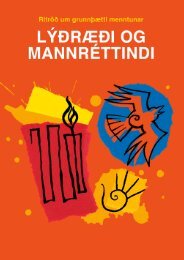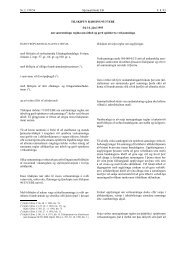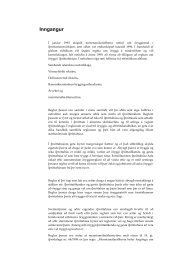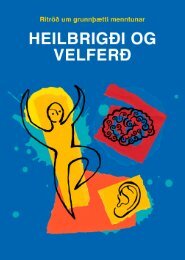Arts and Cultural Education in Iceland : Professor Anne Bamford
Arts and Cultural Education in Iceland : Professor Anne Bamford
Arts and Cultural Education in Iceland : Professor Anne Bamford
Create successful ePaper yourself
Turn your PDF publications into a flip-book with our unique Google optimized e-Paper software.
There is a lack of connection between the teacher education provisions <strong>in</strong> the university <strong>and</strong><br />
those <strong>in</strong> the conservatoire <strong>and</strong> art academies. In a smaller national system closer collaboration<br />
between the arts tra<strong>in</strong><strong>in</strong>g <strong>and</strong> the education tra<strong>in</strong><strong>in</strong>g could encourage more streaml<strong>in</strong>ed<br />
opportunities. This area though is not without tension as discussions are largely unresolved<br />
between whether arts experts, with some education, or education experts with the arts make<br />
the best teachers. The follow<strong>in</strong>g vignette 35 (5.2.6) reveals the complexity around these issues <strong>in</strong><br />
Icel<strong>and</strong>:<br />
Vignette 5.2.6 Two different k<strong>in</strong>ds of musician/teacher identity.<br />
Revolutionary changes have been made over the last decades <strong>in</strong> the education of music teachers <strong>in</strong> Icel<strong>and</strong>. The Music<br />
Conservatory used to have an education department until 2001. In that year a new school was founded <strong>in</strong> Reykjavík,<br />
the Icel<strong>and</strong>ic Academy of the <strong>Arts</strong>. As a university, it took over the music education programme – as all teachers’<br />
tra<strong>in</strong><strong>in</strong>g <strong>in</strong> Icel<strong>and</strong> is on University level. The teachers’ programme at the Icel<strong>and</strong>ic Academy of the <strong>Arts</strong> is now a one<br />
year programme after B.mus degree on <strong>in</strong>strument <strong>and</strong> is still develop<strong>in</strong>g ways <strong>in</strong> which it will be organised <strong>and</strong><br />
delivered.<br />
At the same time the music teachers’ programme <strong>in</strong> the University of <strong>Education</strong> <strong>in</strong>itiated major changes <strong>in</strong> their<br />
curriculum where future teachers now have fewer lessons on <strong>in</strong>strument such as piano <strong>and</strong> focus more on group<br />
teach<strong>in</strong>g <strong>and</strong> teach<strong>in</strong>g methods. If students’ knowledge <strong>in</strong> music is good before they enter the programme it is all very<br />
well – but often it is not, <strong>and</strong> therefore their overall knowledge of music is at m<strong>in</strong>imum when they graduate. The<br />
result is that they do not have the capacity to perform what is expected of them as music teachers <strong>in</strong> public schools.<br />
These two <strong>in</strong>stitutions appear to reflect respectively each of the two different k<strong>in</strong>ds of musician/teacher identity. On<br />
the one h<strong>and</strong> the Academy emphasises the ‘musician’ <strong>and</strong> musical development, whilst the University of <strong>Education</strong> is<br />
widely seen as neglect<strong>in</strong>g the cont<strong>in</strong>ued musical development of students <strong>and</strong> places a significant emphasis on<br />
pedagogical issues <strong>and</strong> the mak<strong>in</strong>g of ‘teachers’.<br />
It could be simplistic to blame only pre-service teacher education. Such an idea fails to<br />
recognise that professional development of teachers <strong>in</strong> service (especially <strong>in</strong> the middle years of<br />
their teach<strong>in</strong>g career) might provide a better key for unlock<strong>in</strong>g the potential with<strong>in</strong> schools. The<br />
UNESCO report suggests that while <strong>in</strong>itial teacher education is beneficial, more overall impact<br />
can be achieved <strong>in</strong> chang<strong>in</strong>g attitudes <strong>and</strong> structures with<strong>in</strong> schools by focus<strong>in</strong>g on mid-career<br />
teachers. 36 As the follow<strong>in</strong>g quote suggests, teacher education needs to be thought of as a<br />
lifelong process, rather than someth<strong>in</strong>g that occurs only <strong>in</strong> the first few years of tra<strong>in</strong><strong>in</strong>g: “It’s<br />
important to me how you plan learn<strong>in</strong>g as a life long process... learn, teach for a while, then back<br />
to school...”<br />
As noted <strong>in</strong> earlier chapters, the ongo<strong>in</strong>g professional development of teachers is vital for<br />
high quality arts <strong>and</strong> cultural education. As was <strong>in</strong>dicated <strong>in</strong> detail <strong>in</strong> earlier sections, the current<br />
opportunities for Icel<strong>and</strong>ic teachers are generally expensive, limited, not practical <strong>and</strong> lack<strong>in</strong>g<br />
lifelong learn<strong>in</strong>g pathways. To counteract that, teacher education could play a vital role <strong>in</strong><br />
professional development. But <strong>in</strong>stead of this be<strong>in</strong>g a focus area requir<strong>in</strong>g significant expansion,<br />
there has actually been a contraction of available offer<strong>in</strong>gs <strong>in</strong> these. Several of the providers also<br />
commented there was a lack of dem<strong>and</strong> <strong>and</strong> attendance at professional development offers:<br />
“We have tried to make offers to teachers <strong>and</strong> the union of textile teachers <strong>in</strong> compulsory school<br />
wants this but then no one comes <strong>and</strong> every one says that time is too short.”<br />
There are also a range of smaller providers that offer courses <strong>in</strong> the arts for perspective<br />
teachers. For example, The Icel<strong>and</strong>ic Musicians’ Union (FIH) has an ‘Academy’. This tra<strong>in</strong><strong>in</strong>g<br />
prepares teachers, but it is not officially recognised as a teach<strong>in</strong>g qualification. This teacher<br />
tra<strong>in</strong><strong>in</strong>g is an extension of previous programmes. It covers work<strong>in</strong>g with ensembles; teach<strong>in</strong>g<br />
35 This vignette is based on an unpublished paper provided by Kristín Valsdóttir, February 2009 p7<br />
36 (<strong>Bamford</strong>, 2006) p 74.<br />
109



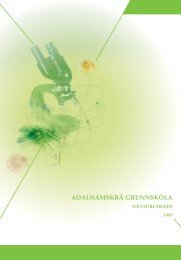
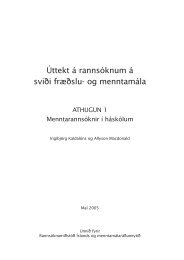

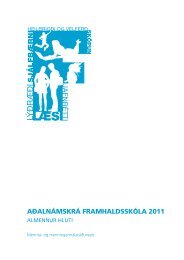
![Aðalnámskrá tónlistarskóla : rytmÃsk tónlist [Eingöngu á rafrænu formi]](https://img.yumpu.com/50843672/1/184x260/aaalnamskra-tanlistarskala-rytma-sk-tanlist-eingangu-a-rafranu-formi.jpg?quality=85)
